UPSC Daily Current Affairs- 1st November 2023 | Current Affairs & Hindu Analysis: Daily, Weekly & Monthly PDF Download
GS-I
Sardar Vallabhbhai Patel Birth Anniversary
Subject: Modern History
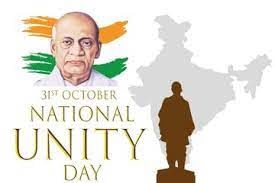
Why in News?
The Prime Minister of India has paid tributes to Sardar Patel on his Jayanti.
Early Life of Sardar Patel
- Sardar Vallabhbhai Patel was born on October 31, 1875, in Nadiad, Gujarat.
- He had a diverse career, working as a barrister, an activist, a freedom fighter, and a political leader, all of which contributed significantly to India's struggle for independence.
- In his early years, he showed little interest in Indian politics, but his perspective evolved under the influence of Mahatma Gandhi, and by 1917, he wholeheartedly adopted Gandhi's principle of Satyagraha (Non-violence).
- Patel played a pivotal role in organizing mass campaigns against British policies and held positions as the Municipal Commissioner and President of Ahmedabad from 1917 to 1928.
- He was a prominent leader within the Indian National Congress and served as the first Deputy Prime Minister and Home Minister of India from 1947 to 1950.
Contributions in India’s Freedom Struggle
- Kheda Satyagraha (1917): Patel played a crucial role in organizing and leading the protest against the unjust land revenue tax imposed by the British. He provided strong leadership, urging the local community to join the movement.
- Non-Cooperation Movement (1920-22): Patel recruited around 300,000 members and raised 1.5 million rupees for the movement. He advocated boycotting British goods and promoted the use of Khadi to symbolize economic and cultural self-sufficiency.
- Bardoli Satyagraha (1928): Patel stood in solidarity with the people of Bardoli who were suffering from famine and increased land taxes. The main strategy was refusing to pay taxes to the British. Patel's efforts in Bardoli earned him the title 'Sardar,' meaning 'leader' or 'chief.'
- Leadership in Indian National Congress: He presided over the Karachi Session in 1931, known for ratifying the Gandhi-Irwin Pact and passing a resolution on Fundamental Rights. Patel also chaired the Central Parliamentary Board in 1934.
- Civil Disobedience Movement (1930-34): Patel advocated boycotts of British goods, tax refusal, and nonviolent protests. He aligned himself with Gandhi in promoting individual disobedience, leading to his arrest and imprisonment for about 9 months.
- Quit India Movement (1942): Patel organized protests and strikes, delivering powerful speeches across India to mobilize people against British rule. He implemented strategies to protect national leaders from arrest and spearheaded fundraising efforts for the movement.
- Support for Liberal Industrial Policy (1948): This policy laid the groundwork for India's economic growth and development.
Contributions in Unification of India
- Key Role in Political Integration: He played a pivotal role in the political integration of India and the Indo-Pakistani War of 1947.
- Integration of Princely States: He was instrumental in persuading almost every princely state to accede to India, earning him the nickname 'Iron Man of India' for his commitment to national integration.
- Diplomacy, Persuasion, and Coercion: He successfully brought these states under the Indian government through a combination of diplomacy, persuasion, and coercion, ensuring India's territorial integrity and unity.
- Administrative Reforms: Sardar Patel played a crucial role in establishing a unified administrative structure for newly independent India.
- Patron Saint of Civil Servants: He is remembered as the 'patron saint of India's civil servants' for pioneering the creation of the modern All India Services system, particularly the Indian Administrative Service (IAS), which he referred to as the 'steel frame' of India.
- Sardar Vallabhbhai Patel National Police Academy: He contributed to the establishment of the prestigious Sardar Vallabhbhai Patel National Police Academy in Hyderabad for training police officers.
- Promotion of National Integration: He promoted the 'Idea of India' as a single nation, emphasizing the importance of national unity despite the country's diversity.
Honours
- Iron Man of India: Recognized for his pivotal role in ensuring India's unity and integrity.
- Bharat Ratna: He was posthumously awarded India's highest civilian honor in 1991.
- National Unity Day: Celebrated annually on October 31 to honor Sardar Patel's birth anniversary.
- The Statue of Unity: Unveiled on October 31, 2018, in Kevadia, Gujarat, it is the world's tallest statue, commemorating his 143rd birth anniversary.
- Sardar Sarovar Dam: Constructed on the Narmada River in Gujarat.
Conclusion
- Patel’s life and work serve as a beacon of selfless service, unity, and indomitable determination. His role in shaping modern India is unparalleled, and his legacy continues to inspire generations of Indians and his contributions to nation-building are celebrated every year on his birth anniversary, observed as National Unity Day.
- His vision and dedication towards national integration cemented his place as one of the most influential leaders in Indian history.
Source: PIB
Tamil Lambadi embroidery
Subject: Art and Culture
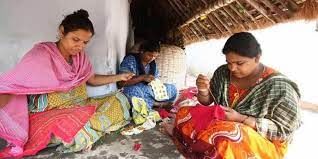
Why in News?
Porgai Artisan Association Society, with 60+ women, has been making and selling embroidered clothes to ensure that there is awareness about the art form and that it is passed on to the next generation
About Tamil Lambadi embroidery:
- Lambadi embroidery is a long-standing tradition within the Lambadi community, serving both functional and decorative purposes.
- It plays a crucial role in their cultural identity, and the Lambadi people have made consistent efforts to preserve this craft.
- Lambadi women are the skilled artisans behind this intricate embroidery, working with vibrant cotton threads on cotton and silk fabrics.
- The traditional embroidery designs predominantly feature geometric patterns, including squares, rectangles, and circles.
- These designs also draw inspiration from the local environment, incorporating elements from the nearby forests, birds, fruits, and flowers.
- The elderly women within the Lambadi tribe continue to wear the Petia, a traditional five-piece outfit crafted from Mushru silk sourced from Kutch.
Key facts about the Lambadi community
- The Lambanis, also referred to as Banjaras, primarily inhabit regions in Telangana, Andhra Pradesh, Tamil Nadu, and Karnataka.
- This community, known by various names across the country, has transitioned from their nomadic lifestyle and established permanent settlements known as Tandas.
- They communicate in a language known as Gor Boli, alternatively called Lambadi, which falls under the Indo-Aryan Group of Languages. It is worth noting that Lambadi has no written script.
Source: The Hindu
GS-II
Republic of Dagestan
Subject: International Relations
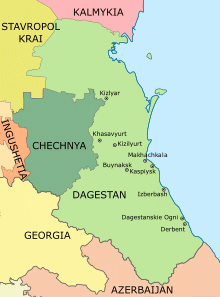
Why in News?
Russian police recently said they had arrested 60 people suspected of storming an airport in the Muslim-majority Caucasus republic of Dagestan, seeking to attack Jewish passengers coming from Israel.
About the Republic of Dagestan:
- Location: Dagestan is a province of Russia, part of the Russian Federation, and one of the 22 republics within the country.
- Geography: It is situated in the eastern part of the North Caucasus and shares borders with Georgia and Chechnya to the west, Azerbaijan to the south, and the Caspian Sea to the east.
- Population: Dagestan has a population of approximately 3.2 million people.
- Religion: The majority of the population in Dagestan follows Sunni Islam.
- Capital: The capital city of Dagestan is Makhachkala, which is located on the Caspian Sea coast. It was conquered by the Russian Imperial Army in the 19th century and served as a significant pre-revolutionary trading port.
- Ethnic Diversity: Dagestan is known for its remarkable ethnic and linguistic diversity, with over 40 different ethnicities and more than 30 languages spoken. It is often referred to as the "Mountain of Languages" or "Mountain of Nationalities," and some ethnic groups are concentrated in just a few villages.
- Dominant Ethnicity: The Avars are the largest ethnic group in Dagestan, making up about one-fifth of the province's population. Other significant ethnic groups include Dargins, Kumyks, and Lezgins. Ethnic Russians account for about 10 percent of the population.
- Insurgency: From 2007 to 2017, Russian security forces were engaged in a battle against an armed insurgency led by various Islamist militant groups in Dagestan, as well as neighboring Chechnya and Ingushetia.
- Economic Significance: Dagestan serves as a crucial conduit for major oil and gas pipelines running from the Caspian Sea to the Russian heartland. Additionally, the region itself possesses oil and gas reserves.
Source: The Hindu
Prisoner’s Dilemma
Subject: International Relations

Why in News?
The Defense Minister emphasized the importance of global collaboration over conflicting interests, using the “Prisoner’s Dilemma” concept.
About
- The Prisoner’s Dilemma is a well-known scenario in game theory that examines strategic decision-making.
- It involves two players who have been arrested and face a decision between cooperation (C) or betrayal (B) toward their partner.
- The game is represented using a payoff matrix, where the choices of cooperation and betrayal lead to different outcomes with varying payoffs.
- Mutual Cooperation: When both players cooperate, they both receive moderate sentences, resulting in a win-win outcome.
- Mutual Betrayal: If both players betray each other, they both receive relatively high sentences, leading to a lose-lose scenario.
- Temptation to Betray: If one player cooperates (C) while the other player betrays (B), the betrayer receives the lowest sentence (temptation payoff), and the cooperator receives the highest sentence.
- Dilemma: The situation arises when every player, driven by their own self-interest, is inclined to betray their partner to reduce their own punishment.
- Paradox of Rationality: This game illustrates a paradox in rational decision-making, where choices that make sense for an individual result in an overall unfavorable outcome for everyone involved.
- Applications: The Prisoner's Dilemma model is utilized in different real-world contexts like International Relations, Economics, Politics, and Environmental cooperation. It helps analyze the difficulties in fostering cooperation and trust in competitive settings.
Source: Indian Express
GS-III
Debrigarh Wildlife Sanctuary
Subject: Environment and Ecology

Why in News?
Recently, a pair of elusive wild dogs, often referred to as Dholes, have made a rare appearance in Debrigarh Wildlife Sanctuary in Odisha’s Bargarh district.
About Debrigarh Wildlife Sanctuary:
- Location: Situated between the Hirakud Dam on the Mahanadi River and its reservoir in the state of Odisha.
- Wildlife Sanctuary: Designated as a wildlife sanctuary in the year 1985.
- Historical Significance: Gains prominence due to the association with the renowned freedom fighter Veer Surendra Sai, who used 'Barapathara' within the sanctuary as his base during the rebellion against the British.
- Fauna: Known for the ease of spotting various animals, including Indian Bison, Wild Boars, and Sambhar.
- Flora: Features a dry deciduous forest that attracts numerous winter birds.
Key facts about Dhole or wild dogs
- Wild Canid Species: The species is a wild canid found in the forests of central, south, and southeast Asia.
- Distribution:
- Northern Range: Extends as far north as Siberia.
- Southern Range: Extends as far south as some Malaysian islands.
- Western Range: Extends as far west as the Indian peninsula.
- India Clusters: Found in three clusters across India, including the Western and Eastern Ghats, the central Indian landscape, and North East India.
- Stronghold Regions: The Western and Eastern Ghats are stronghold regions for these canids.
- Habitat: They inhabit a variety of environments including dense jungles, steppes, mountains, scrub forests, and pine forests.
- Conservation Status:
- IUCN Status: Endangered.
- CITES Listing: Appendix II.
- Wildlife Protection Act 1972: Listed under Schedule II.
Source: The Hindu
Black Stork
Subject: Environment and Ecology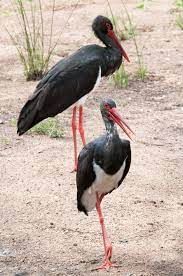
Why in News?
Recently, a Black Stork, a species rarely seen, has been spotted in the Hastinapur Wildlife Sanctuary in Uttar Pradesh.
About Black Stork:
- Species Name: The black stork (Ciconia nigra) is a sizable bird belonging to the stork family Ciconiidae.
- Habitat: This bird species breeds in wet, coniferous, and mixed woodlands, and it can also be located in grasslands, farmlands, and along the shores of lakes and rivers during the winter.
- Migration: The black stork is a long-distance migrant, with European populations spending their winters in tropical Sub-Saharan Africa, while Asian populations migrate to the Indian subcontinent.
- Distribution: The black stork is primarily found in Europe, Asia, and various African countries.
- Conservation Status: According to the International Union for Conservation of Nature (IUCN), this species is categorized as "Least Concern," indicating it is not currently facing significant conservation threats.
Key facts about Hastinapur Wildlife Sanctuary
- Location: Situated in the state of Uttar Pradesh.
- Geography: Located adjacent to the northern banks of the Ganga River within the districts of Muzaffarnagar and Bijnor.
- Landforms: Comprises diverse landforms, including wetlands, marshes, dry sand beds, and gentle sloping ravines.
- Biodiversity: Home to a rich variety of wildlife, including Swamp Deer, Leopard, Wild Cats, Wild Otter, and Pythons, among others.
- Conservation Project: Forms part of the "Asia Flyway" project, attracting numerous migratory birds—both native and foreign—that congregate near the numerous water bodies in the area.
Source: Times of India
Urban Expansion & Flooding
Subject: Disaster Management
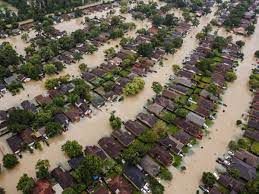
Why in News?
A recent Nature journal study, conducted by the World Bank reveals that urban expansion into flood-prone zones has intensified flood risks.
Findings of the Study
- Increase in Flood-Prone Settlements: A study shows a more than twofold surge in human settlements in flood-prone regions over a 40-year period since 1985.
- Middle-Income Countries Dominate: Urban settlement expansion in flood-prone areas is led by middle-income countries, surpassing both low and high-income nations.
- Global Patterns: East Asia sees the highest growth rate of urbanization in flood-prone regions, while Sub-Saharan Africa and North America witness the lowest expansion. India is categorized as a low-middle-income country in this context.
Reasons
- Topographical Oversight: City expansions often disregard the local topography, resulting in adverse outcomes such as the 2022 Bengaluru floods.
- Impact on Socio-economic Groups: Urban expansion into flood-prone areas adversely affects various socio-economic segments, with informal settlements carrying higher risks, as evidenced in the case of the Yamuna floodplains.
- Lack of Governance Mechanism: Inadequate governance mechanisms fail to prevent environmentally unsustainable development in flood-prone regions.
- Regulatory Gaps: Environmental regulations primarily focus on major projects, leaving out smaller-scale alterations in localities, resulting in disparities.
- Violation of Regulations: Widespread non-compliance with regulations, as exemplified by eco-tourism resorts encroaching on forested lands and significant infrastructure construction on river floodplains, remains a persistent issue.
Way Forward
- Comprehensive scientific mapping of flood-prone areas in every city is essential.
- Implement improved storm-water management plans, including the installation of storm-water drains to collect and divert rainwater in flood-prone areas.
- Prioritize resilience in housing construction to withstand floods.
- Upgrade and protect low-income housing, focusing on their flood resilience.
- Learn from successful examples of stilt houses in riverside settlements for flood-prone areas.
- Promote resilient construction practices that adapt to flood risk and safeguard vulnerable communities.
Source: Down To Earth
Lewis Model
Subject: Economy

Why in News?
A Lower share of the manufacturing sector in employment has raised questions about the implementation of the Lewis Model in India.
What is the Lewis Model?
- Economist William Arthur Lewis set out the dual sector model in his 1954 publication, “Economic Development with Unlimited Supplies of Labor.” The model seeks to provide a framework for understanding how relatively poor countries can develop economically.
- It begins by assuming that one of the characteristics shared by poor countries is that their economies tend to consist largely of “subsistence sectors” in which the supply of labor is very large and the amount of capital invested per worker is very low.
- The Lewis model describes a path whereby a developing economy can foster the growth of a new “capitalist sector,” which will employ a growing share of the excess labor available from the subsistence sector. Over time, this capitalist sector can come to eclipse the subsistence sector, causing the overall economy to grow.
Why has the Lewis Model in India not worked?
- Agriculture employed about two-thirds of India’s workforce till the early nineties. The share fell from 64.6% to 48.9% between 1993-94 and 2011-12. Currently this share is 45.8% .
- For manufacturing, the share in employment rose marginally, from 10.4% to 12.6%, between 1993-94 and 2011-12. In 2022-23 the share is 11.4%.
- The jobs being generated outside agriculture are mostly in low-paid services and construction, not in manufacturing and high-productivity services.
- Hence in India the virtuous structural transformation, entailing a transfer of surplus labor from “subsistence” to “capitalist” sectors hasn’t worked.
- However, in the case of China the Lewis model was successful. The country, from the late 1970s to the 2000s, leveraged its demographic dividend and large pool of surplus rural labor to become “the world’s factory”.
Source: Indian Express
|
38 videos|5283 docs|1116 tests
|
FAQs on UPSC Daily Current Affairs- 1st November 2023 - Current Affairs & Hindu Analysis: Daily, Weekly & Monthly
| 1. What is the significance of Sardar Vallabhbhai Patel's Birth Anniversary? |  |
| 2. What is Tamil Lambadi embroidery? |  |
| 3. What is the Republic of Dagestan? |  |
| 4. How does the Prisoner's Dilemma concept apply in decision-making? |  |
| 5. What is the impact of urban expansion on flooding? |  |
















